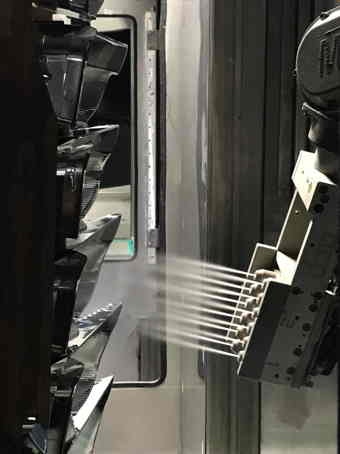In-line CO2 cleaning process to clean lighting components before coating reduces reject rates significantly lower since changing over to different cleaning system
August 8, 2018

A US processor has discovered significant performance differences between several CO2 liquid cleaning systems for cleaning injection-molded part surfaces prior to metallization. Since switching to quattroClean technology from German company acp, Nanogate Jay Systems has been able to reduce the contamination-related reject rate of vehicle lighting components, which are cleaned before being coated, to almost zero.
|
The patented two-component ring nozzle ensures good and even cleaning results. The array used by Nanogate Jay Systems is fitted with twelve nozzles. [Image source: acp – advanced clean production] |
|
By adjusting process parameters, such as volume flows for compressed air and carbon dioxide, cleaning time and motion sequences, exactly to suit the parts being cleaned, the contamination-related reject rate could be reduced to almost zero. [Image source: acp – advanced clean production] |
Nanogate Jay Systems focuses on production of lighting components for leading auto and truck OEMs and many of this parts must be metallized. “Every day, among other parts, we produce around 25,000 reflectors for headlamps from bulk molding compounds (BMC), which are coated and metalized using PVD [plasma vapor deposition] processes,” says CEO Rick Taylor. The company also makes exterior panels, roof coverings and ABC pillars, as well as interior fittings ranging from center consoles to dashboards, loudspeaker covers and door components.
Before being coated, the reflectors undergo a cleaning step to remove dirt due to handling, fingerprints and de-burring residues. To improve cleaning results and integrate this process step into the production line, some time ago the company invested in two carbon dioxide (CO2) cleaning systems from different manufacturers. However, the performance of both systems was reportedly poor. One proved to be inefficient because approx. 40 percent of the CO2 was wasted rather than being used for the process. With the other system, cleaning results were poor, causing an extremely high contamination-related reject rate of around 10 percent.
Taylor therefore started looking around for a more efficient cleaning system. “On a visit to one of our parent companies in Germany, I noticed the quattroClean system from acp and was impressed,” recalls Rick Taylor. The CEO got in touch with acp (advanced clean production GmbH) and explained his requirements. After conducting cleaning tests in the company’s technical center on some components, Nanogate Jay Systems ordered the first quattroClean system. “Besides the good cleaning performance, the extremely competitive price convinced us to buy,” adds Taylor.
The cleaning solution uses non-combustible, non-corrosive and non-toxic liquid CO2 as a medium, which has an almost indefinite shelf-life. It is supplied via cylinders or tanks.
The core of the quattroClean system is a patented, wear-free circular two-component nozzle, through which the CO2 is fed. On exiting the nozzle, the liquid CO2 expands to form fine CO2 crystals. These are bundled by a circular jacketed jet of compressed air and accelerated to supersonic speed. The non-abrasive jet of snow and compressed air has a temperature of -78.5°C. Since this can be directed highly accurately, practically all the CO2 is used for cleaning, and the process achieves uniform cleaning results throughout the entire work area.
The high level of cleaning efficiency is based on a combination of thermal, mechanical, sublimation and solvent effects, which are activated when the jet impacts on the cleaning surface. Thanks to these four cleaning mechanisms, the quattroClean system reliably removes filmic contamination, such as residues of separating agents and fingerprints, as well as particulate contaminants like de-burring residues and dust. “We achieve much better cleaning results with this technology and have been able to reduce the contamination-related reject rate to almost zero. It takes less than one year to achieve a return on investment,” remarks Taylor.
Nanogate Jay Systems now uses three quattroClean systems, which are operated six, or sometimes even seven, days a week in three shifts. Tailored by acp to the company’s exact requirements, the systems take the form of a robot with a nozzle array. The latter has twelve nozzles with a total jet width of 120 mm. Liquid carbon dioxide and compressed air are fed to the array via a hose system.
The robots are integrated into the paint and metalizing lines.
The cleaning systems are controlled by a manufacturing execution system developed by Nanogate Jay Systems. “To integrate them, acp worked closely with our programmers, and gave us tremendous support when we put them into operation. It’s no problem at all that the company is in Germany and we’re in the States. They are always available if we need them. However, since the cleaning system has been in operation, no further support has been required”, explains Taylor.
To clean the various reflectors, about 30 part-specific programs are filed. The MES selects the appropriate one in each case. The workpiece carriers containing the reflectors are processed fully automatically. These are cleaned, coated with basecoat, metalized by PVD to apply a reflecting layer of aluminum, and then packed. The dirt cleaned off is swept away by the aerodynamic force of the jet and removed via an integrated extraction unit, thus preventing parts from becoming recontaminated.
Since process parameters, such as volume flows for compressed air and CO2, cleaning time and motion sequences, are adjusted exactly to suit the parts to be cleaned, optimum cleaning results are assured. In addition, only the amount of CO2 or compressed air required for the process is used. “We are so pleased with the quattroClean system and our working relationship with acp that we are already talking about integrating the system into more of our paint lines”, concludes Taylor.
About the Author(s)
You May Also Like






